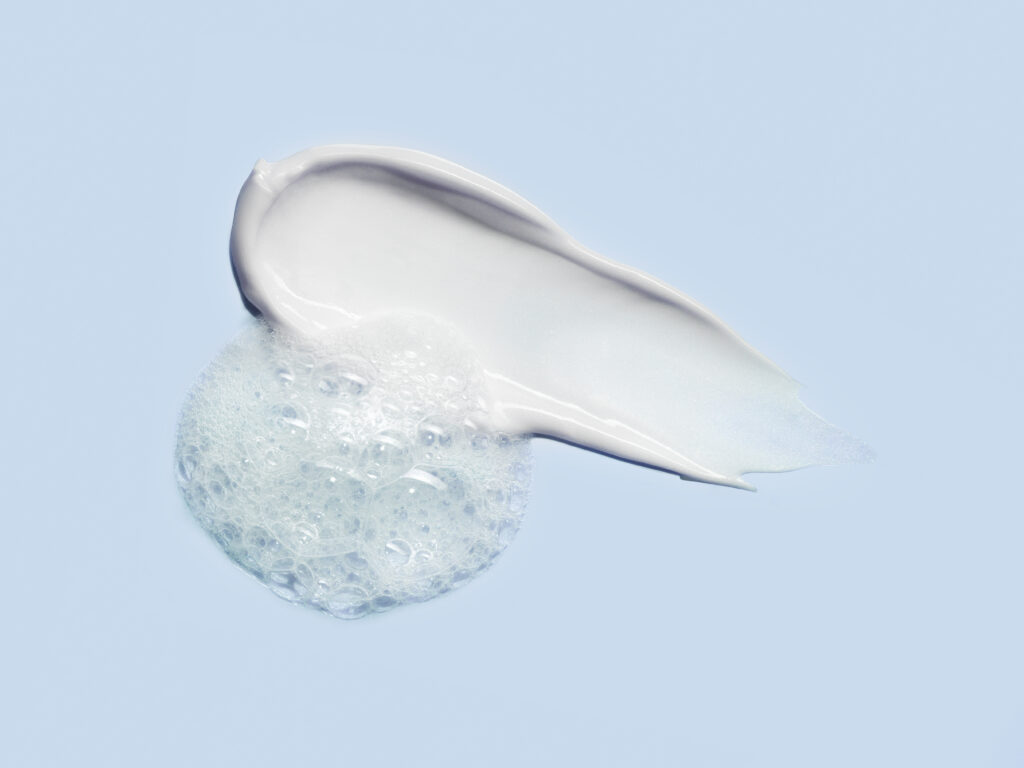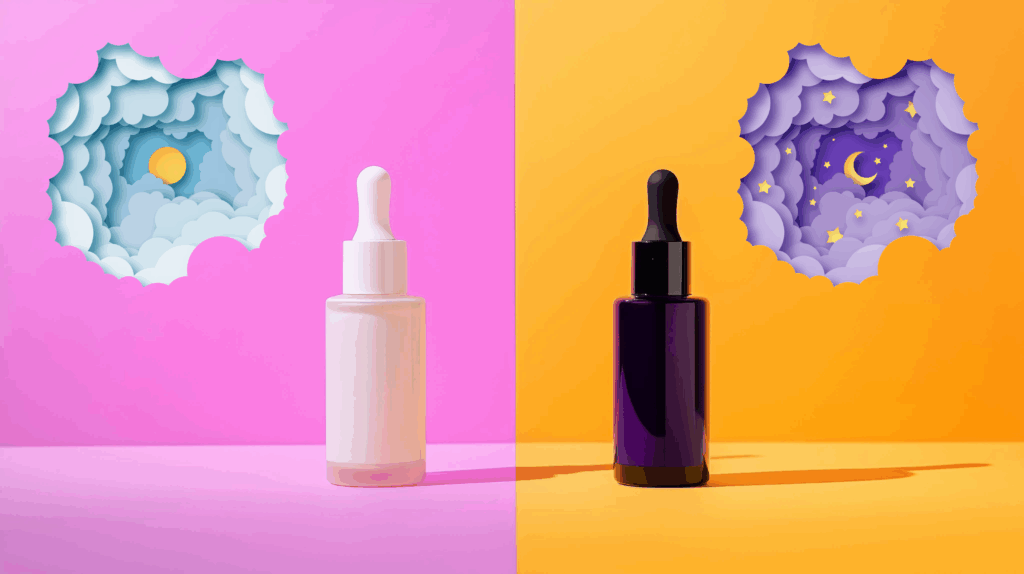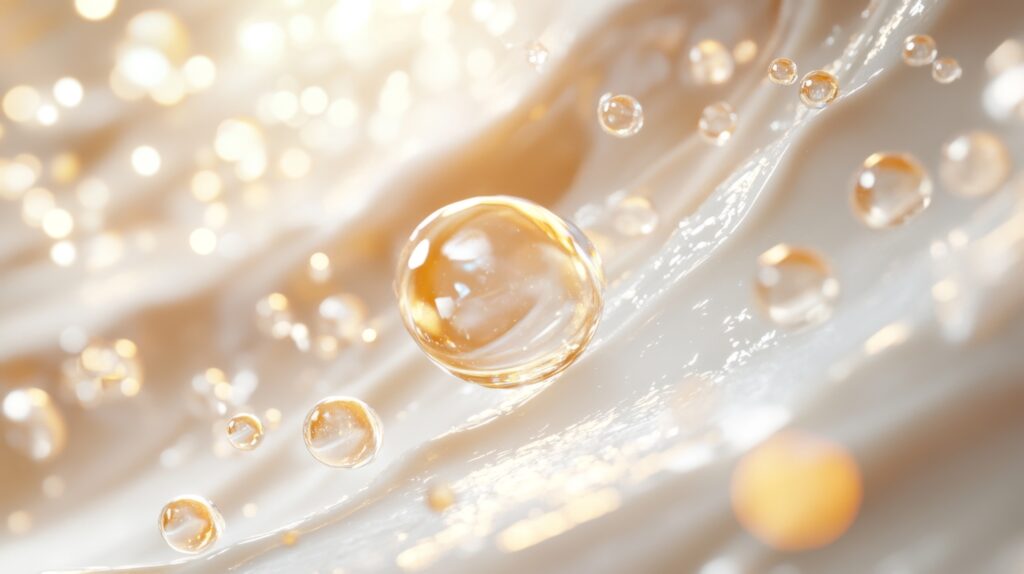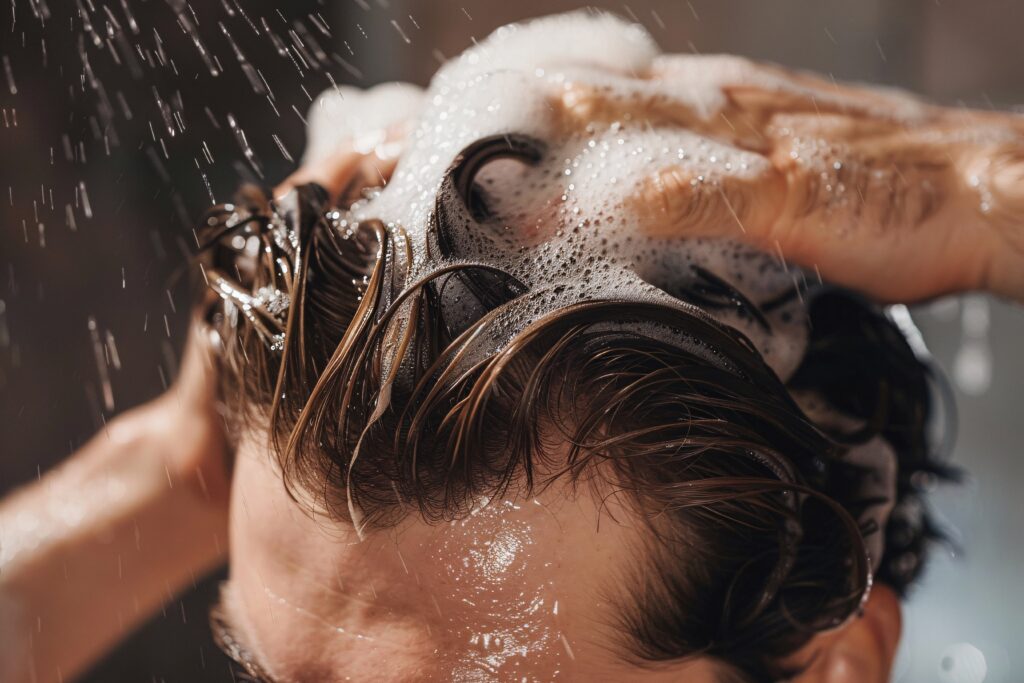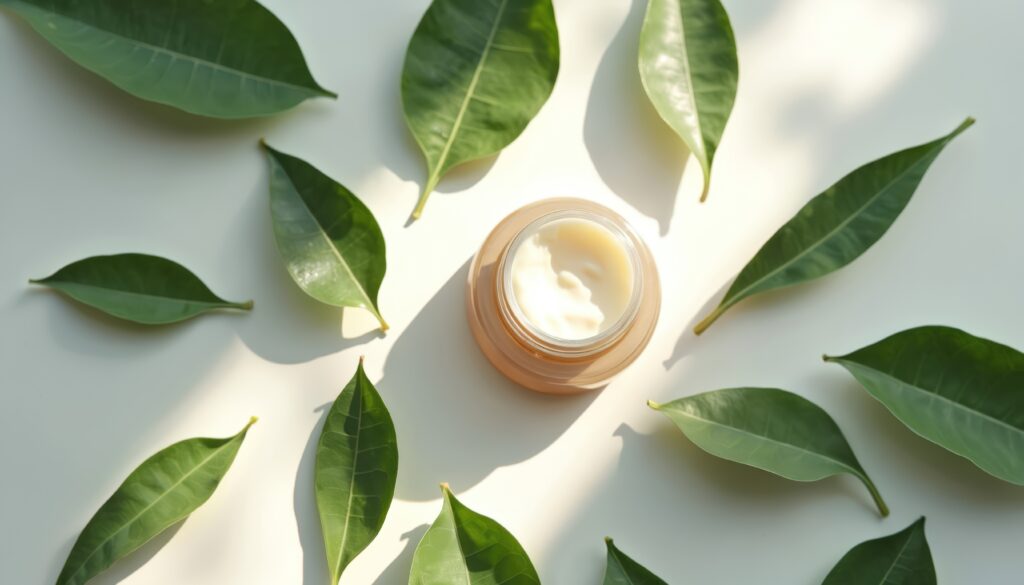The Hidden Variable Behind Skin Barrier Performance
Ceramides have long held a reputation as essential lipids in maintaining skin barrier function. However, conversations around ceramides in formulation often remain surface-level—focused primarily on adding more of them, rather than ensuring the right type and balance. What’s frequently overlooked is the critical interplay between short-chain and long-chain ceramides, and how this balance determines not just barrier strength but also the permeability that governs active delivery. For formulators, the implication is clear: It’s not just about having ceramides in the mix—it’s about having the right ceramide profile.
This overlooked nuance becomes especially important when working with popular actives like retinoids, vitamin C, or niacinamide. While effective for their respective benefits, these ingredients often disrupt ceramide homeostasis in the skin, undermining the very barrier they aim to improve. This is where DL CERAcalm, a “ceramide influencer” derived from the bark of the Indian kino tree (Pterocarpus marsupium), enters the conversation. Rather than act as a topical ceramide itself, DL CERAcalm supports the skin’s natural biosynthesis of both short and long chain ceramides—maintaining the functional balance that is too often destabilized by other actives.
When Barrier Integrity and Efficacy Collide
Today’s cosmetic formulators are under increasing pressure to develop multifunctional products that are both potent and gentle. Consumers expect fast results from serums packed with actives like retinol, vitamin C, and exfoliating acids—but they also demand non-irritating, barrier-safe formulations. The paradox is that many of these very actives are known to disrupt lipid homeostasis in the stratum corneum. For instance, studies have shown that vitamin A, vitamin C and niacinamide show a reduction of ceramide content in reconstructed human epidermis models, potentially compromising barrier integrity over time.
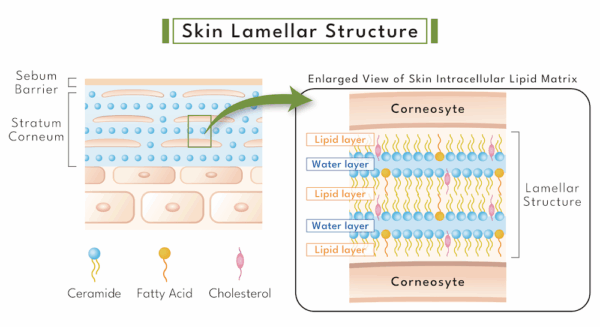
This challenge is compounded by the technical limitations of conventional ceramides. While ceramides like NP, AP, and EOP are common in commercial formulations, their bioavailability is limited. Topically applied ceramides tend to accumulate in skin surface grooves rather than integrate into the skin’s lamellar structure. This means that simply adding more ceramides into a cream or serum doesn’t guarantee functional benefits. Additionally, cosmetic ceramides are expensive and difficult to stabilize in certain formulation types, creating both economic and technical barriers for formulators.
In this environment, the issue is no longer just about delivering ceramides—it’s about supporting the skin’s ability to regulate and rebalance its own lipid environment in the face of disruptive actives.
How DL CERAcalm Modulates Ceramides from Within
DL CERAcalm offers a new approach to ceramide support: instead of trying to replace depleted ceramides from the outside, it helps the skin maintain and regenerate its own ceramide network from within. This plant-derived lipid complex influences ceramide biosynthesis by targeting pathways involved in lipid metabolism and inflammation. In human skin models, DL CERAcalm has demonstrated the ability to preserve both short and long chain ceramides—even in the presence of ceramide-depleting actives like niacinamide, vitamin C, and retinoids.
The key to DL CERAcalm’s value lies in balance. Long chain ceramides are essential for creating the ordered lipid layers that form the skin’s primary water-retaining barrier. Short chain ceramides, by contrast, enhance permeability and facilitate the absorption of active compounds. A healthy skin barrier maintains an equilibrium between the two, allowing for both robust defense and efficient delivery. DL CERAcalm helps uphold this equilibrium—ensuring that a formula doesn’t sacrifice one benefit for the other.
In addition, DL CERAcalm also supports barrier resilience during inflammatory conditions. In a reconstructed human epidermis model mimicking eczema, the addition of DL CERAcalm suppressed cytokine-induced elevation of EOS ceramides, which are often associated with inflammation and barrier dysfunction. This suggests potential benefits for formulations targeting sensitive, reactive, or barrier-compromised skin.
Actives vs. Lipids: Why Potent Skincare Often Compromises the Barrier
Several studies underscore DL CERAcalm’s capacity to maintain ceramide integrity under stress conditions. In a 14-day reconstructed human epidermis (RHE) model, treatments with vitamin A, vitamin C, and niacinamide all led to significant reductions in both short and long chain S-ceramides. DL CERAcalm, however, preserved baseline levels of both types of ceramides—demonstrating its ability to stabilize the skin’s lipid profile even when paired with actives known to disrupt ceramide synthesis. When used in combination with niacinamide, DL CERAcalm prevented the ceramide depletion typically induced by niacinamide alone, enabling formulators to maintain both efficacy and skin comfort.
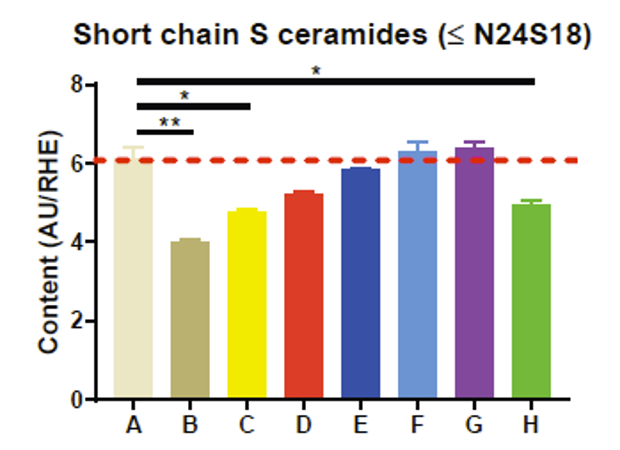
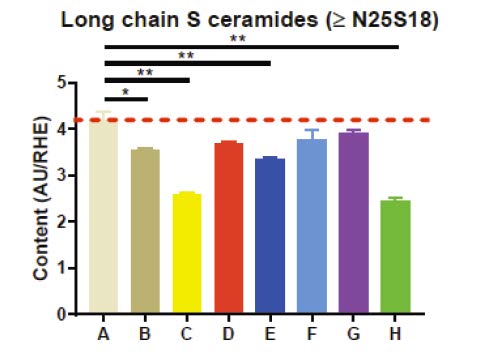

DL CERAcalm also demonstrated an ability to modulate EOS ceramides, a subtype of ultra-long chain ceramides enriched in healthy skin barrier structures. In inflammatory conditions—such as those mimicked in vitro by the addition of pro-inflammatory cytokines—EOS ceramides can become excessively elevated, a phenomenon observed in cases of atopic dermatitis. In the RHE model simulating inflamed skin, the combination of DL CERAcalm with niacinamide significantly suppressed the cytokine-induced increase in EOS ceramides, effectively restoring ceramide levels to baseline. Niacinamide alone failed to produce the same normalization effect. This suggests that DL CERAcalm does more than maintain structural lipids—it plays an active role in restoring a healthy ceramide profile under stress and inflammatory triggers.
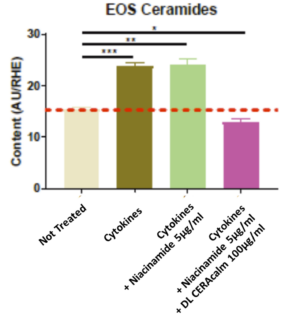
In addition, DL CERAcalm has demonstrated barrier-repair performance in an ex vivo human skin explant model. When applied at 1–3% in both anhydrous and emulsion bases, DL CERAcalm produced a ~20% increase in total ceramide levels over untreated controls after just 24 hours. The same samples also showed an increase in filaggrin expression—up to 19%—marking accelerated barrier recovery at the protein level. Importantly, the vehicle itself (caprylic/capric triglycerides) did not produce any significant changes, confirming that the observed effects were ingredient-specific.
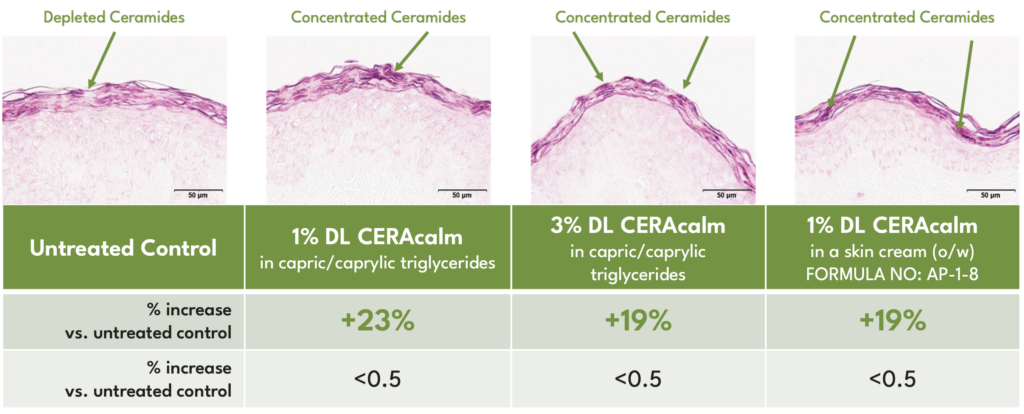
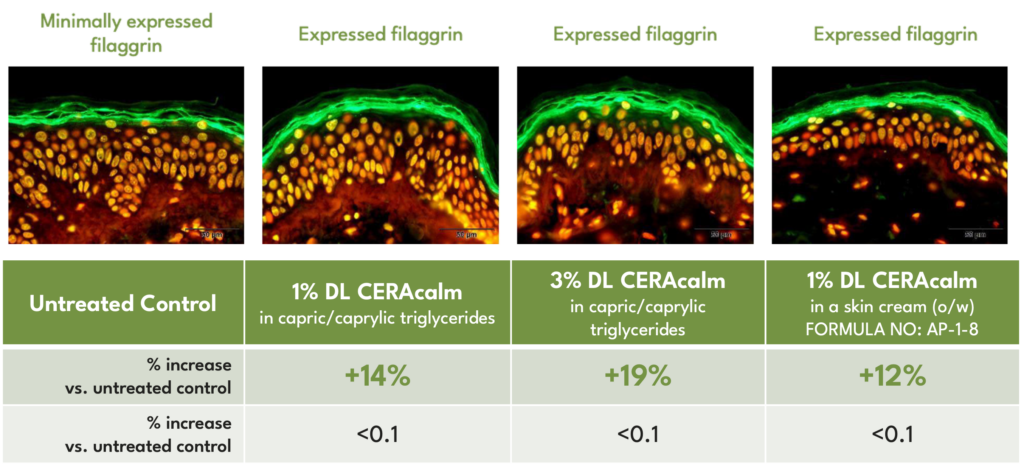
Together, these results position DL CERAcalm as both a stabilizer of lipid homeostasis and a corrector of inflammation-related ceramide imbalances, offering formulators a versatile tool for barrier-focused innovation.
Building Barrier-First Formulas That Don’t Compromise on Actives
As formulation strategies evolve, the demand for high-efficacy products that also respect skin barrier integrity is becoming non-negotiable. With more consumers seeking results-driven actives alongside gentler, barrier-supportive routines, formulators are tasked with finding smarter solutions. DL CERAcalm offers a targeted approach—working with the skin’s biology to restore and maintain lipid balance, rather than relying on external ceramide supplementation. Its ability to enhance resilience without compromising compatibility makes it a valuable asset in building next-generation skincare that performs—without the trade-offs.
DL CERAcalm also opens new doors for pairing with ingredients that would otherwise raise concerns about irritation or barrier damage. Whether you’re building a clinical-grade retinol treatment or a gentle hydration serum for sensitive skin, DL CERAcalm enhances flexibility by preserving the ceramide architecture that keeps the skin functioning optimally. It’s a small addition to the INCI list—but one with outsized impact on product performance and skin health outcomes.
From Lipid Loss to Lipid Logic
Ceramides play a foundational role in skin structure and function—but their effectiveness lies not just in presence, but in proportion. The dynamic balance between short and long chain ceramides is critical for achieving both barrier strength and optimal active delivery. Without that balance, even well-formulated products may fall short in performance or user experience. DL CERAcalm addresses this challenge by supporting the skin’s own ability to maintain ceramide homeostasis, especially when paired with potentially disruptive actives.
DL CERAcalm offers more than functional support—it represents a shift toward formulation that respects the skin’s biology. By helping maintain ceramide equilibrium under stress, it enables formulators to deliver active-rich products without sacrificing barrier integrity.
Consider DL CERAcalm as a foundation for barrier-smart formulation—where performance and skin compatibility go hand in hand.
Resources
- Zhang Q, Flach CR, Mendelsohn R, et al. Topically applied ceramide accumulates in skin glyphs. Clin Cosmet Investig Dermatol. 2015;8:329–337. https://doi.org/10.2147/CCID.S83857
- Industry Research Co. Ceramides in Cosmetics Market Report. 2023. https://www.industryresearch.co
- Kondo A, Takenaka Y, Fujiwara A, et al. Changes in ceramide EOS and disease severity in atopic dermatitis. Exp Dermatol. 2024;33:e15025. https://doi.org/10.1111/exd.15025
- Frontiers in Physiology. Role of Lipid Lamellae in Epidermal Barrier Function. 2022. https://doi.org/10.3389/fphys.2021.804824
- Internal Data, Deveraux Specialties. DL CERAcalm Presentation V2, 2025.



